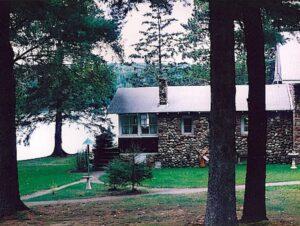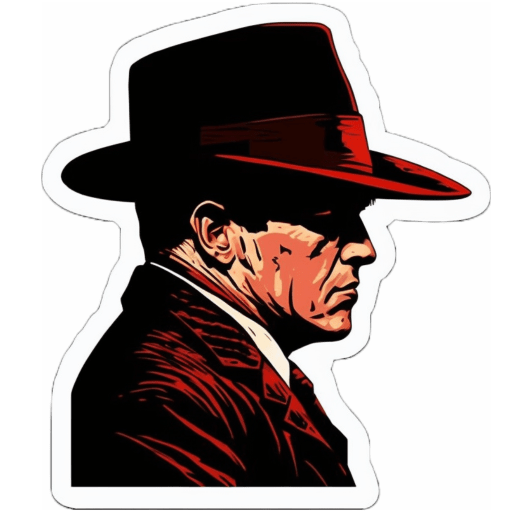Of all the places Al Capone allegedly visited in Wisconsin, the most famous may be “The Hideout” in Couderay (Sawyer County, near Hayward). But is it true or just a marketing gimmick? Let’s look at three perspectives.
One: The Marketing Angle
The first reference I could find to Capone in Couderay was in John Kobler’s Capone biography from 1971 where he says Capone bought a country estate in Couderay for $250,000 around 1926. His source is unknown.

A 1978 article on the Houston family broke the story open. They had purchased the 370-acre 8-room property with a 6-room caretaker house and told the press they were “slow in promoting it” because it was their home and they didn’t want people trespassing to get photos and whatnot. But by 1978, they opened part of it as a restaurant and gave tours. They showed people the “watch tower” that they said may have had gunmen staked out in it. Jean Houston said the property was alleged to have an escape tunnel, but she had not found it.
Jean told the press they had memorabilia on site: hand-carved furniture, a violin case, a staircase with a bullet hole in it, mahogany book cases, and oriental rugs. The 1978 article said Capone was known to visit many other places, including a farm west of Brookfield, Eagle River, Arbor Vitae, Ironwood (Michigan) and the “Beaver Lodge” at Mercer. Some of this list is true, some probably is not.
A November 1981 article claims Capone went there from 1928-1932, and the property was tied up in litigation after his death in the 1940s. Jean Houston clarified that her husband Eugene Houston was a restaurant owner (the Mayfield) in Chicago, and bought the property in 1959 after his retirement. When he died, Jean needed an income, so we turned the lodge into a tourist spot with her son Guy and daughter Carol.
A 1986 article has Jean saying there’s a jail cell in the house where Capone kept enemies, and there are rumors he flew in whiskey from Canada, landed on nearby Cranberry Lake, and then trucked it to Chicago. This article is the first time I see them mention a former caretaker who lived on the hill. Guy Houston said, “I think his name was Charlie. He was pushing 90 when he died.” (More on this below.)
October 2000, Guy Houston auctioned the property off. The firm handling the sale expected multi-millions. The paper covering the sale interviewed Sawyer County historian Andy Wittwer said he had heard from a barber named Shorty Grey who said he used to cut Capone’s hair while guards watched. A game warden had also told Wittwer he had to stop in occasionally because Capone was a poacher. No one met the minimum.
In April 2008 the bank foreclosed on the property and had to auction it off in September 2009. Starting bid was $2.6 million. No one paid, so Chippewa valley Bank took ownership.
Two: Mario Gomes Responds
Mario Gomes, a top Capone expert, says “it was mob connected, but not owned by Al Capone as touted.” Gomes says attorney and mob associate Edward O’Hare owned it and it changed hands in 1942 — the signatures were Mary and Louis Lipschutz. Lipschutz was apparently Jack Guzik’s brother-in-law. They sold under the Northern Trust Company to William Carlton. In 1955, the land was sold again through a Sheriff’s sale to Marcel Bachner, a trustee from the Bank of Austin. It 1959, it was sold to Guy Houston. Was it ever used by gang members and was Capone there? Very possible, but unknown.
Gomes says when the Houston acquired it, the house had no furniture in the place at all so that furniture was not original. The supposed gun tower was just a water pumping station they used to pump water up from the lake. The jail was just a cold room that was used to refrigerate food and beer. The bullet hole in a staircase was added by Edward O’Hare when he stayed there. (Not sure how Gomes knows this last part)
In short, was Capone there? Very possible. But the “memorabilia” and stories were all hype.
Three: An Inside Story?
In April 1981, 91-year old Lola Allison spoke with the Janesville newspaper. She said she grew up in Missouri, moved to a coal mining town in Illinois after marrying Charles Allison around 1905, and then opened a chili restaurant. Charlie made illegal whiskey on the side. He traveled widely looking for work, as far as Alaska. One day, their home burned down leaving nothing but the whiskey still.
Charlie took up work in Chicago operating a cement mixer, and there met Capone’s men. They offered him a caretaker role in Couderay, which he took. Lola and kids joined and they stayed in a house on the property. Lola cook and washed. She said the deed was held by an attorney, “John O’Hare,” a friend of Capone.
On one occasion, friends visited Lola from Evansville and saw the gun case in the house. Someone grabbed a gun wrong and it went off, blasting a hole through the ceiling and destroying a featherbed upstairs that Lola had to repair before the Chicago men got back. The men always treated her family with respect, and one time took her daughter Velma to Ladysmith to buy a fur coat. Lola was gifted a walrus tusk cribbage board by Capone, and Charlie was gifted a deer hunting rifle.
Charlie played for the Couderay baseball team, and once invited the team to shower at the lodge after beating a nearby Indian team. He failed to clean up after them before going to town for drinks, and Fred Goetz arrived and found the place a mess. Charlie was fired and they moved in with their daughter in Couderay before later moving to Janesville.
This story strikes me as believable. It doesn’t make huge claims, and it’s first person. It isn’t a story about a “grandfather” but a person staking their own reputation on the tale. There is even a piece of recorded evidence: the 1930 census has the Allison family in Couderay working as “caretakers” for a “private residence.” So they are in the right place with the right job. And Lola made no effort to make money off the story, so she has less reason to embellish.
The lack of photographs is unfortunate, but not a dealbreaker for me. The Goetz connection is also possible. He fled Chicago for Minnesota in 1929 and was killed in 1934. If Charlie was fired around 1932, Goetz could very well have been visiting from Minnesota and very much alive. (If Charlie still worked there in 1935 this is a problem, but we don’t know the exact year.)
Lola says “John” O’Hare, but this may be her memory or a newspaper typo. Edward O’Hare was a Capone lawyer (and father of WWII legend Edward O’Hare who O’Hare Airport is named for). O’Hare turned on Capone during his tax trial and was murdered in November 1939.
Three and a Half: Gomes Again
I sent Mario Gomes the Lola Allison article — he didn’t reference it on his site, so thought it might be new to him. He kindly responded, “My take is there were indeed gangsters connected to that cabin in those days. No doubt! Ownership proves it. Now Capone living there or owning it is nonsense. This was the Houstons’ doing as an add-on for drumming up business. Now, Allison is probably truthful. She met some of the gangsters there, maybe one of them gave her that cribbage item. He had a fedora and was stout. People then will say that it was Al Capone.” Gomes included an article clipping about a mayor who was mistaken for Capone because of similar body shape and fashion sense.
Conclusion (At Least for Now)
I am less skeptical than Mario Gomes. I think if someone is the caretaker of a property and they meet someone who looks like Al Capone, and is surrounded by people who treat him like Al Capone, it’s a better than 50-50 chance it’s Al Capone. Now, does that mean I think Lola Allison met Capone? I don’t know. She references getting these modest gifts, but doesn’t really say anything about interacting with him. Perhaps Goetz (or whomever) gave them the items and said, “Al appreciates what you do for us.” So they are allegedly from him, but not personally given.
Either way, the Houston story seems to be almost entirely made up. And if Capone was there, he was not there often. It was hardly a “hideaway” so much as a place to pop in and say hi to friends. But I don’t think this should make the property less interesting. A connection to Edward O’Hare, Jake Guzik or Fred Goetz is a story in itself. It doesn’t grab headlines and it doesn’t sell tour tickets, but it’s still an interesting piece of gang history.
